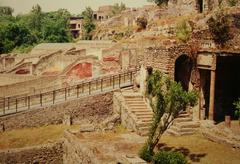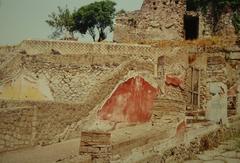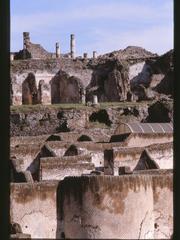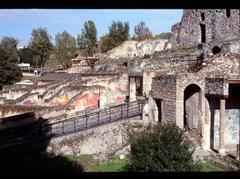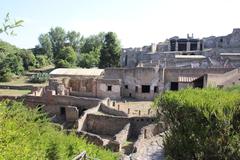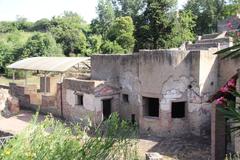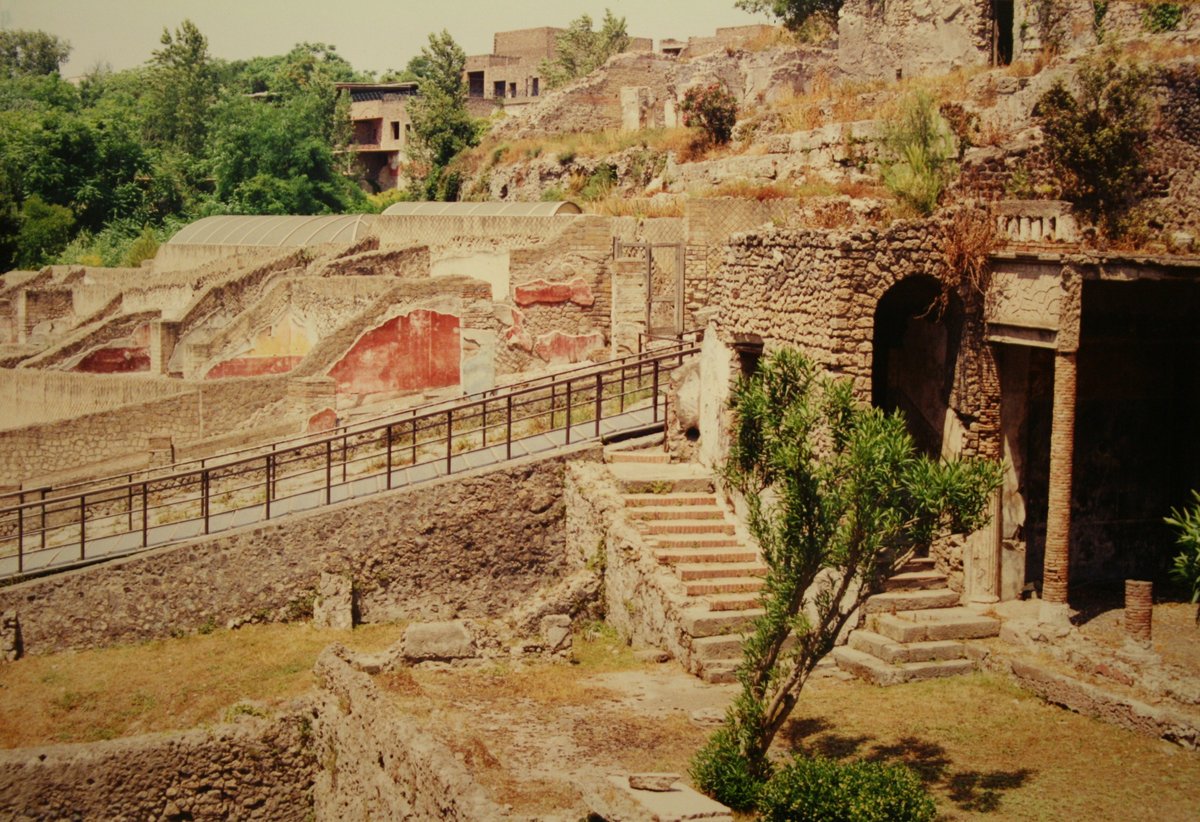
Suburban Baths Pompeii: Visiting Hours, Tickets, and Historical Sites Guide
Date: 15/06/2025
Introduction
The Suburban Baths (Terme Suburbane) of Pompeii stand as an extraordinary testament to Roman ingenuity, offering a vivid window into ancient daily life, societal norms, and architectural innovation. Nestled just outside the city’s western walls near Porta Marina, these baths were among the last monumental public bathing complexes built before the catastrophic eruption of Mount Vesuvius in 79 AD. Their strategic location, advanced engineering, and unique art—including candid erotic frescoes—make them a must-see for history enthusiasts, art lovers, and curious travelers alike.
This comprehensive guide provides everything you need to plan your visit: historical context, architectural highlights, preservation status, ticketing details, accessibility information, and tips for exploring both the Suburban Baths and nearby Pompeii attractions. For up-to-date information and immersive resources, consult the official Pompeii Archaeological Park website, the Audiala app, and other scholarly sources. Whether you seek insight into ancient engineering or the social dynamics of Roman bathing culture, the Suburban Baths promise a truly unforgettable journey. (Pompeii Archaeological Park, ISPRS Archives, Bring You)
Table of Contents
- Introduction
- Historical Context
- Architecture and Engineering
- Social and Cultural Significance
- Excavation and Conservation
- Visiting Information
- Frequently Asked Questions (FAQ)
- Summary and Final Tips
- References and Further Reading
Historical Context
Construction and Location
The Suburban Baths were constructed during the early Imperial period, likely under Emperor Tiberius (14–37 AD), as part of Pompeii’s urban expansion westward. Their proximity to the harbor and the Porta Marina gate made them an attractive amenity for both residents and travelers, reflecting a shift in the city’s social geography as defensive priorities gave way to civic development.
Water Supply and Ownership
The baths were made possible by Pompeii’s connection to the Aqua Augusta aqueduct, ensuring a steady and robust water supply for their elaborate facilities. Like the city’s other major baths (Stabian, Forum, Central), the Suburban Baths were publicly owned and played a vital role in daily life, serving as hubs of relaxation, hygiene, and social interaction.
Architecture and Engineering
Design and Heating Systems
The Suburban Baths feature a sophisticated multi-level design, terraced into the natural slope of the city’s southern escarpment. Over 100 rooms span five to six floors, including the traditional Roman bathing sequence: apodyterium (changing room), frigidarium (cold room), tepidarium (warm room), caldarium (hot room), and natatio (open-air swimming pool). This vertical layout maximized available space and facilitated efficient movement.
A hypocaust heating system—comprising underfloor brick columns (pilae), wall flues (tubuli), and wood-fired furnaces (praefurnia)—enabled precise temperature control across the various rooms. Water was delivered via lead and terracotta pipes from storage cisterns and managed by an intricate drainage system to prevent flooding. (ISPRS Archives, Academia.edu, Pompeii Archaeological Park)
Decorative Elements
Inside, visitors will find stunning Fourth Style frescoes with mythological and marine themes, intricate black-and-white geometric mosaics, stucco reliefs, and marble-faced pools and benches. The baths’ apodyterium is renowned for its explicit erotic frescoes, offering rare insight into Roman perceptions of sexuality and communal life. Archaeological finds—including grooming tools, unguent containers, and coins—reveal the everyday routines of Pompeians.
Social and Cultural Significance
Bathing was a central element of Roman social life, and the Suburban Baths exemplified this tradition. Unlike more centrally located public baths, their location near the city’s edge made them accessible to both locals and visitors from the harbor. The complex played host to a diverse clientele, fostering interaction, relaxation, business, and even discreet encounters—reflected in the candid artwork discovered within.
Excavation and Conservation
Systematic excavation began in the 20th century, revealing remarkably preserved architecture and artifacts due to the protective layer of volcanic ash. Evidence shows the baths were repaired following the 62 AD earthquake, indicating their sustained importance. Modern conservation techniques—including digital 3D modeling and non-invasive imaging—guide preservation efforts, focusing on structural stabilization and the safeguarding of delicate wall paintings. Initiatives like the Great Pompeii Project and international collaborations have enhanced site management, improved visitor infrastructure, and ensured the baths’ longevity. (Bring You, Monuments & Sights, The Art Newspaper)
Visiting Information
Hours and Tickets
- Opening Hours: Generally, the Pompeii Archaeological Park is open daily from 9:00 AM to 7:00 PM (last entry at 5:30 PM). Seasonal variations may apply, so always consult the official website before your visit.
- Tickets: Admission to Pompeii (including the Suburban Baths) is approximately €16–18 for adults, with discounts for EU citizens aged 18–25 and free entry for children under 18. Tickets can be purchased online or at the site entrance; advance booking is recommended to avoid queues.
- Access: Due to conservation and crowd control, access to the Suburban Baths may be limited to small, guided groups, especially during peak periods. (The Art Newspaper)
Accessibility
The baths are partially accessible. While modern walkways and ramps have been installed in key areas, the ancient multi-level design and uneven terrain mean some sections remain challenging for those with mobility concerns. Contact park staff or check accessibility information for the latest updates.
Getting There
The Suburban Baths are located near the Porta Marina (Marine Gate), within easy walking distance from the main train station and bus stops. Clear signage within the park directs visitors to the baths and other major landmarks.
Facilities and Site Navigation
Restrooms are available at main entrances and major attractions. Large bags are not permitted; free cloakroom service is offered at entrance gates, with additional luggage storage at the nearby Pompeii Scavi train station. Site maps and informative signage help visitors navigate the complex and understand its features. (Nomad Epicureans)
Guided Tours and Audio Guides
Expert-led tours provide in-depth context about the baths’ history, engineering, and artwork. Audio guides are available for flexible self-paced visits and can be rented near ticket counters with a deposit. (Bring You)
Nearby Attractions
Enhance your visit by exploring nearby highlights such as the Forum, the Stabian Baths, the Amphitheatre, and the Villa of the Mysteries. The Porta Marina area also offers panoramic views of the ancient harbor.
Visitor Conduct and Safety
To help preserve this fragile heritage, visitors must refrain from touching frescoes or mosaics, climbing on structures, or leaving litter. Photography is generally allowed, but flash and tripods may be restricted in sensitive areas. Parental discretion is advised in rooms with explicit artwork. Remain on marked paths and heed staff instructions for your safety and the site’s protection. (Pompeii Archaeological Park)
Frequently Asked Questions (FAQ)
Q: What are the Suburban Baths’ visiting hours?
A: Usually 9:00 AM to 7:00 PM, with last entry at 5:30 PM. Confirm current hours on the official website.
Q: How do I buy tickets?
A: Purchase online in advance or at the entrance. General admission covers the Suburban Baths.
Q: Are the Suburban Baths accessible for visitors with disabilities?
A: Partial accessibility is available. Some areas have steps and uneven ground.
Q: Are guided tours available?
A: Yes, including both group tours and audio guides.
Q: Can I take photos?
A: Photography is permitted, but flash and tripods may be restricted. Respect signage, especially in areas with sensitive frescoes.
Q: Are the frescoes suitable for children?
A: The apodyterium contains explicit erotic frescoes; parental discretion is advised.
Q: What other sites can I visit nearby?
A: The Forum, Amphitheatre, Stabian Baths, and Villa of the Mysteries are all close to the Suburban Baths.
Summary and Final Tips
The Suburban Baths illustrate the grandeur and complexity of Roman civilization through their innovative multi-storey design, refined art, and advanced engineering. Their candid frescoes provide unique insight into ancient attitudes toward sexuality and leisure, while ongoing preservation ensures their survival for future generations. When visiting, plan ahead by checking hours, booking tickets, and considering accessibility needs. Pair your tour with other Pompeii landmarks for a deeper appreciation of the city’s remarkable history. Approach your visit with respect for the site’s fragility, and contribute to its legacy by following all preservation guidelines.
For a truly immersive experience, download the Audiala app for detailed audio tours and stay updated by following official channels. The Suburban Baths are ready to educate and inspire—step into their ancient halls and discover the spirit of Pompeii.
References and Further Reading
- Pompeii Archaeological Park Official Website
- ISPRS Archives, Urban Bath Complex Study
- Bring You, Preservation Efforts at Pompeii
- The Art Newspaper, Pompeii Bath Complex Opening
- CNN, Archaeologists Unearth Thermal Spa in Pompeii
- Monuments & Sights, Pompeii Preservation
- Nomad Epicureans, Visiting Pompeii
- Pompeii Archaeological Park, Accessibility
- Audiala Mobile App
